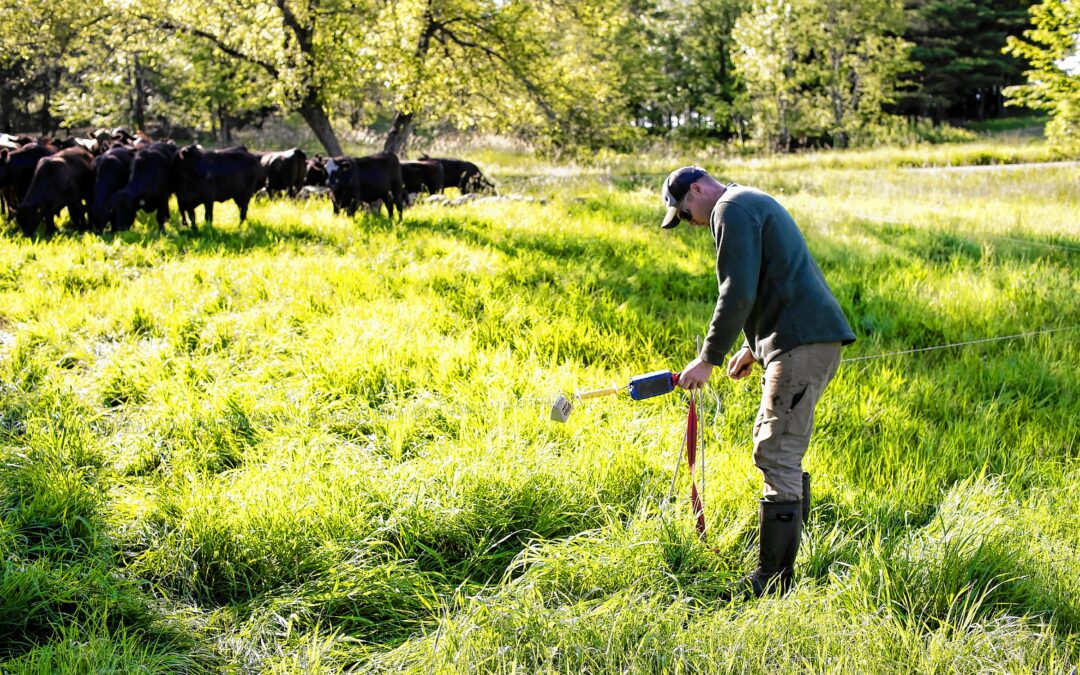After spending an hour recently with Jeff Moore of Windswept Maples Farm in Loudon as he demonstrated an automated gate system for beef cattle, I came to a realization: Farming is an optimization problem.
Optimization problems are common in computing and economics. They involve figuring out how to get the best possible outcome from a host of interlocking variables that you may or may not control.
It’s the same with farming but here the variables are more – well, variable. They range from consumer habits, planting schedules and fuel prices to labor availability, disease and tomorrow’s weather.
For Moore and farmers like him, things are even more complicated because their wish not to contribute to the climate emergency means they aim for two often conflicting goals: Staying in business this year and not damaging the planet long-term.
Hence the automated gates, which Moore recently invited me to see.
Mechanically, they’re simple. Called Batt-Latch, they’re just a portable timer that can release a spring-loaded section of electric fence when desired, allowing animals to pass through to a new field.
As straightforward as that sounds, it allows Moore to graze a dozen tons of cows in ways that can store more carbon in the soil (hooray, planet!) while keeping the animals healthy and happy (hooray, business!). Most importantly, he can do it without running back and forth to leased pastureland a few miles from Windswept Maples home farm.
“The old New England system was a big pasture – the back 40 – and you’d put the animals out and leave them for weeks. Now, all of our animals are moving every single day,” said Moore, 34. “The trouble with that is I’ve got to go to the animals every single day. There’s a lot of management responsibility and a lot of time.”
Over the course of the season, cattle on Moore’s pasture stay in portions of fields as small as half an acre, depending on the quality of the grasses, enclosed by a portable fence consisting of a single strand of electrified polywire. Every day a pre-set Batt-Latch pops open and the cows, seeking better grass, move to the next bit of field.
It has taken Moore a couple of years to make this system work because of the biggest problem with keeping livestock: Water supply. Moore had to run lines and design a jerry-rigged tractor that hauls an auto-filled water tub from site to site before he could really start moving cows daily.
But now it works well enough that the cows have learned. When we visited they were all standing impatiently at the fence, staring at the Batt-Latch as if willing it to open.
So what’s the big deal about moving cows every day? It controls how they eat.
“When you’re grazing cows, you want them to eat the top half of the plant and leave the bottom half – a minimum of 4 inches, the more the better. That makes the roots grow,” he explained, gesturing at tangled mats on the ground of a pasture that his cattle, one- and two-year-old Angus/Hereford crosses, had just left. “They leave the bottom half and trample it down; building all this stuff on the soil surface. That will break down and that’s what turns into carbon in the soil, gets cycled back into the system – that’s what is feeding your next growth of grass.”
If you leave cattle on land for too long, they’ll eat the good stuff right down to the ground and ignore the stuff they don’t particularly like. That’s bad for the long-term health of the grasses and soil, which in turn is bad for the cattle eating there.
I asked Moore whether this system works financially compared to the standard scenario of keeping cattle enclosed and feeding them grain and silage. It’s complicated, he said.
Pasture-fed beef fetches more money but the cattle take longer to put on weight; it takes more time and effort but requires less fertilizer for corn and hay fields, which has doubled in price, and less big machinery (“My dad was fixing a (hay) rake the other day; bearings are $150 apiece, and bearings go all the time.”) It requires more land, a real obstacle in New Hampshire, but less waste management.
In the end, Moore said, double-entry bookkeeping isn’t the only thing that matters. The family members who own and operate Windswept Maples – parents Larry and Melissa and brother Brad, who with Jeff is the eighth generation to farm here – do their optimization calculations based on more than dollars.
“In agriculture, you’re making a living off the land … If I’m degrading the system and taking out more than what’s there, then as a family farmer that’s not sustainable. My children aren’t going to have an opportunity to make a living off the land. We’re trying to put more into the system so that it improves, so that it becomes easier over time,” Moore said.


 Return to the Concord Monitor
Return to the Concord Monitor